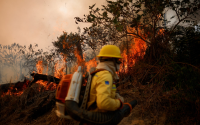16 June 2006The Independent
President George Bush has announced that he intends to create the world's largest marine conservation area across a broad swath of the Pacific, surprising and delighting his environmentalist critics who have had little but withering criticism of the "toxic Texan" over the past five and a half years.
The marine sanctuary, tentatively named the Northwestern Hawaiian Islands National Monument, will cover 140,000 square miles, stretching from Hawaii to Midway Atoll, site of a Second World War battle between the United States and Japan. It includes small islands, atolls and many precious coral reefs. The area is home to about 14 million seabirds, including albatrosses and terns, as well as green turtles, monk seals and spinner dolphins. It contains about 7,000 indigenous animal and bird species found nowhere else in the world.
The sanctuary, which may eventually be given a native Hawaiian name, will be slightly larger than Australia's Great Barrier Reef - currently the largest marine protected area in the world - and cover an area bigger than all the United States' existing marine sanctuaries and land-bound national parks combined. Commercial activity will be banned, and the eight fishing boats currently permitted to enter the area will have their licences phased out over the next five years.
Environmentalists, more used to heaping scorn on a Bush administration that has consistently eroded protections for national parks and forests on land, were unambiguous in their praise and said they hoped to see the White House do more of the same in future.
"We're ecstatic. This is a major step forward for the United States, and we're hopeful this signals a new approach to marine conservation," said Lisa Speer, an oceans specialist with a lobby group, the National Resources Defence Council.
She said she now hoped the US would take the lead in protecting other coral habitats on the high seas.
Just this week, the United Nations was conducting talks on ways to mitigate the threat to deep-ocean coral reefs from bottom-trawl fishing, and Ms Speer said she hoped the White House's initiative would give a decisive push to the conservationist cause.
Politically, there were grounds to be sceptical about the initiative, with some thinking it could be a "greenwash". The Bush administration is badly in need of some positive coverage in the run-up to November's mid-term elections, and it could be seen as a bid for popularity.
Unlike many of the national parks and forests in the continental US, the marine area in the Pacific is not eyed jealously by energy or mining interests with close ties to the White House. The protected area has almost no human population, and the eight families with fishing permits do not live there.
Most environmentalists, however, preferred to take the President at face value than question his motives. The White House, for its part, explained that President Bush took a personal interest in the question after viewing a television documentary about the coral reef archipelago in April. The film was made by Jean-Michel Cousteau, son of Jacques Cousteau, who was present at the White House screening and was personally congratulated by the President.
Environmentalists and Hawaiian politicians, led by Governor Linda Lingle, a Republican, have lobbied the administration to create such a protection area for the past five years. At first, the White House showed little interest, and even in the past few months President Bush considered referring any possible creation of a marine sanctuary to Congress for ratification.
Yesterday, pending an official announcement, Mr Bush was expected to invoke the 1906 Antiquities Act, which grants presidents the right to create protection areas single-handedly. The only previous time he has invoked the Act was to protect a burial ground in Manhattan where 20,000 slaves and free blacks were laid to rest in the 18th century. The Bush administration has, in fact, shown less interest in environmental conservation than any presidency in memory. Not only had the White House not established any new conservation areas, it had repeatedly eroded protections for existing ones and lobbied to open them up to commercial exploitation. The biggest battle has been over the Arctic National Wildlife Refuge in Alaska, which the administration has tried - and so far failed - to open up to oil and gas drilling. But there have been many others.
The Department of the Interior, along with state and local officials, have encouraged oil and gas leases on the edge of national parks and wilderness areas where they risk being a blight on the landscape and a serious pollution hazard. Affected areas include the red rock canyons of Utah and Yellowstone National Park, which straddles northern Wyoming and southern Montana.
The administration has given the go-ahead for logging and road-building in the Tongass National Forest in Alaska, which Bill Clinton tried to protect in the dying days of his administration. It has loosened regulations on logging and building in all national forests, and reversed a ban on snowmobiling in the Yellowstone and Grand Teton National Parks.
The record in marine conservation has been slightly better, but nothing prepared experts for yesterday's announcement.






